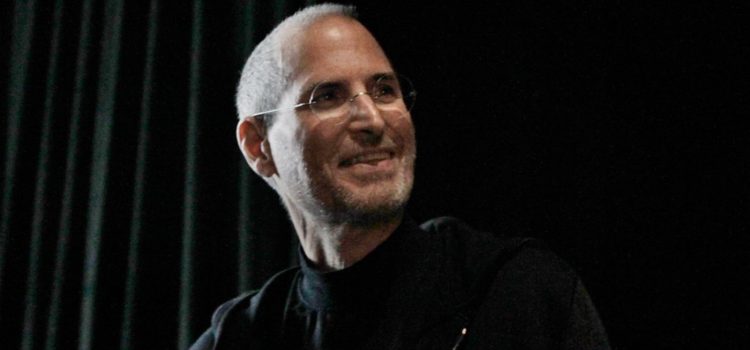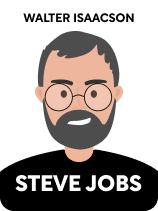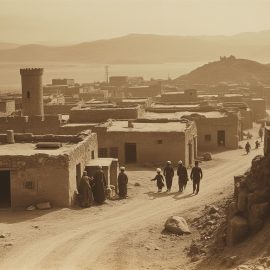

This article is an excerpt from the Shortform book guide to "Steve Jobs" by Walter Isaacson. Shortform has the world's best summaries and analyses of books you should be reading.
Like this article? Sign up for a free trial here.
What was Steve Jobs’s life like? What did he accomplish in his lifetime?
Steve Jobs was as much a product of his time as he was one of its chief architects. His rise to fame and tumultuous life mirrored the whirlwind of the digital revolution.
Learn more about Steve Jobs’s life from his self-titled biography by Walter Isaacson.
Formative Years (1955-1974)
In 1971, Jobs met Steve Wozniak, who was five years older but still a child at heart. Jobs and Wozniak bonded over electronics, as well as their love of pulling pranks. After reading about a way to hack the telephone network, Wozniak designed a circuit that he and Jobs used to make long-distance prank calls. Jobs hit on the idea of selling copies of the circuit to students at Stanford. Isaacson points out that this business model would later become the model for Apple, with Wozniak designing the system and Jobs responsible for packaging and marketing. This was the moment Steve Jobs’s life began to take a successful turn.
After graduating from high school in 1972, Jobs enrolled in Portland, Oregon’s Reed College. While diving head-first into the early ’70s counterculture, Jobs developed an interest in Zen Buddhism, with its stark, minimalist values that he would keep over the years. He would also develop a fixation on extremely limited vegan diets and extended periods of fasting.
Jobs enjoyed his time at Reed, but he detested taking required classes. He eventually dropped out but persuaded the school to let him audit classes he was interested in for free. After leaving school for good, Jobs traveled to India, where he hoped to continue his spiritual pursuits, diving into self-deprivation and asceticism. (Shortform note: In Becoming Steve Jobs, Brent Schlender and Rick Tetzeli explain that after college, Jobs felt tempted to lead the lifestyle of a monk, though he was far too ambitious. He was attracted to the spiritual aspects of asceticism found in Hindu beliefs and was also drawn to Buddhism’s quest for perfection.)
The Birth of Apple (1975-1977)
After coming home from India, Jobs reunited with Wozniak at a time when a larger network of computer hobbyists was forming. This wider community gave their partnership a springboard from which they would make a lasting mark on the world. Jobs and Wozniak went from nobodies to industry-shaking pioneers so quickly that it’s almost hard to imagine.
At a meeting of the Homebrew Computer Club, Wozniak watched a demonstration of the new Altair 8800 computer, the first home computing system to include a microprocessor chip. Seeing the Altair gave Wozniak the idea of putting a microprocessor into a terminal he was currently designing. It worked, and Wozniak became the first person ever to type on a home computer keyboard and see text appear on a screen.
Wozniak wanted to share his idea with the other Homebrew members, but Jobs convinced him that they could sell pre-printed circuit boards instead of giving the design away for free. The two scraped together their savings to fund their new partnership, which Jobs dubbed “Apple Computers” after an apple orchard commune he’d worked at in college.
Wozniak and Jobs introduced the Apple I at the Homebrew Computer Club, where it caught the attention of a local computer dealer. Jobs’s parents’ garage became their first factory, where friends and family became the assembly line to manufacture the Apple I circuits.
Already thinking ahead, Jobs decided their next model should be a fully integrated system that required no assembly by the user. He intended to take the personal computer from a hobbyist’s toy to a product for the general public. He and Wozniak went into business with Mike Markkula, formerly at Intel, to fund Apple’s expansion and production costs.
The Apple II debuted in 1977, kicking off the personal computer industry.
Introducing the Mac (1978-1984)
Even with Apple’s initial success, new computer systems were spreading like wildfire, and Jobs kept his finger to the wind, looking for the next move the industry would make. Not only would Jobs lead the next revolution in computer design, but he would also take a stand in what would become the defining contest within the computer world of the 1980s.
In the late ’70s, Xerox was developing a Graphical User Interface (GUI) that allowed users to operate a computer by activating icons on a “desktop” with a mouse. Xerox wanted shares in Apple’s next expansion, so in 1979 Jobs was given a demonstration of what their engineers were working on. According to Isaacson, Jobs was able to bully his way into seeing more of Xerox’s projects in development than their researchers wanted to show him.
With IBM already claiming victory on the PC battlefield, Jobs prepared a dramatic unveiling of Apple’s new graphics-based computer, the Macintosh. Kicking off the campaign was a cinematic Superbowl commercial that depicted IBM as a dystopian Big Brother and Apple as a daring rebel.
The commercial was followed by a torrent of publicity leading up to the computer’s public unveiling. At the climax of the event, the Macintosh introduced itself through a voice-simulator program.
From Pitfalls to Pixar (1985-1995)
After the triumph of the Mac’s introduction, Jobs would face a series of defeats. While his visionary insights had brought him success, his unrelenting perfectionism and need for control undermined his ability to lead. When he lost control of Apple, his following ventures would prove unsuccessful until he found a way to merge his passion for design with his love of the arts.
After the initial surge of Macintosh purchases, sales began to fall off. Despite the computer’s intuitive operating system, its processor was slow and it lacked an internal hard drive. In addition, Isaacson says that Jobs started making poor business decisions, such as trying to oust Apple’s then-president. Engineers on the Mac team began to resign, and Apple’s board rearranged the company’s structure so that Jobs was stripped of any real power. Jobs left the company to found another of his own, taking several high-ranking colleagues with him.
While this was taking place, George Lucas needed to sell off his computer graphics division. Isaacson says that Jobs wanted to buy it outright but instead became its principal investor. Renamed “Pixar,” the new company integrated software and hardware to make art, which touched on all of Steve Jobs’s passions in his life.
A Triumphant Return (1996-2010)
In Jobs’s absence, Apple’s market share and profitability plummeted. Jobs made a deal to come back in an advisory capacity, along with NeXT’s key engineers and programmers. Soon it became clear that Jobs was running Apple from behind the scenes. Jobs’s priority was to cull Apple’s bloated product line so the company could focus on essentials.
The first new project he developed was the iMac, an intuitive, all-in-one computer that took the company back to the values of the Macintosh. In 1998, the iMac became the fastest-selling Apple product so far.
Instead of selling iMacs in the big-box stores of the day, Isaacson claims that Jobs wanted to control the experience of buying an iMac. He pushed for the creation of the Apple Store, which would be specifically designed to communicate the innovative values of the company. When they first opened in 2001, the stores were predicted to fail. Instead, they drew 20 times as many customers as expected and made over $1 billion within the first year of operation.
Next on Jobs’s list of new products was a portable MP3 player. The iPod propelled sales of iMacs and gave the Apple brand a more youthful feel. What’s more, says Isaacson, the iPod repositioned Apple from being a mere computer company into a wider market.
Seeing the possibilities of merging the iPod with cellular phones, Jobs launched the iPhone as a combination mobile phone, widescreen iPod, and portable internet device all in one, while replacing the clunky keypads of earlier smartphones with an elegant touchscreen interface. By the end of 2010, over 90 million iPhones had sold, cornering half of the global market.
Battle With Cancer (2003-2011)
By his mid-40s, Jobs had already revolutionized the field of computing several times over. Isaacson says that Jobs feared he’d die young and felt driven to accomplish as much as he could within the time he was given. In this, he was prescient.
Steve Jobs’s life came to a halt in 2003 when, at the age of 48, a tumor was found on his pancreas. Though it was discovered soon enough for treatment, Jobs declined to have surgery and instead insisted on fighting the cancer with alternative medical treatments.
Jobs kept the fact that he still had cancer secret, especially from Apple’s employees and shareholders. By 2008, it had spread to his liver and his illness could not be kept hidden any longer. Apple’s stock went down, and speculation about his health ran wild.
By July 2011, the cancer had reached his bones. His last act at Apple was to arrange a smooth transition of power to those who would carry on in his footsteps. Steve Jobs passed away at the age of 56, surrounded by his family, on October 5, 2011.

———End of Preview———
Like what you just read? Read the rest of the world's best book summary and analysis of Walter Isaacson's "Steve Jobs" at Shortform.
Here's what you'll find in our full Steve Jobs summary:
- A no-fluff look into the life of Steve Jobs
- How Jobs changed the technology landscape
- What it was like to work with and for Steve Jobs






